The Castle of Dénia
Dénia is home to a large Moorish castle named Castle of Dénia (38°50’34.9″N 0°06’26.6″E) on a rocky crag overlooking the port and the city. It was built in the 11th and 12th century and offers views around the sea, the city and the surrounding area. Located within the castle is the Palau del Governador (Governor’s Palace), which once housed the Archeological Museum, displaying various artifacts and amphorae, now transferred to Calle Caballeros n° 3. Dénia is also home to the Museu Etnològic (Ethnological Museum), which provides additional context on the city’s history and social and cultural heritage.
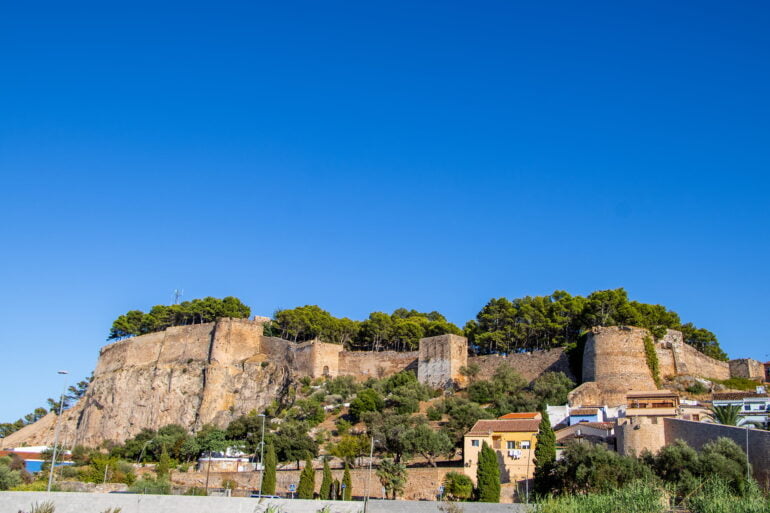
The Castle of Dénia
The castle is located in the heart of the city, atop a 60-meter-high mound. The entrance is just a 4-minute walk (220 m) from Loreto 29. Here’s a map for easy access to the castle. Access is via San Francisco Street (Sant Francesc), in Les Roques neighborhood. You will come across a door with a horseshoe arch—an Islamic architectural feature—that leads to a landscaped path ending at the ticket office.
There is a tunnel under the Castle, acting as a shortcut to avoid going around it, going from Plaza del Consell (Carrer de La Mar), near to the Tourist Office, until Ronda des les Muralles 2, used as an air-raid shelter during the Spanish Civil War. Open daily 06:30-02:00.
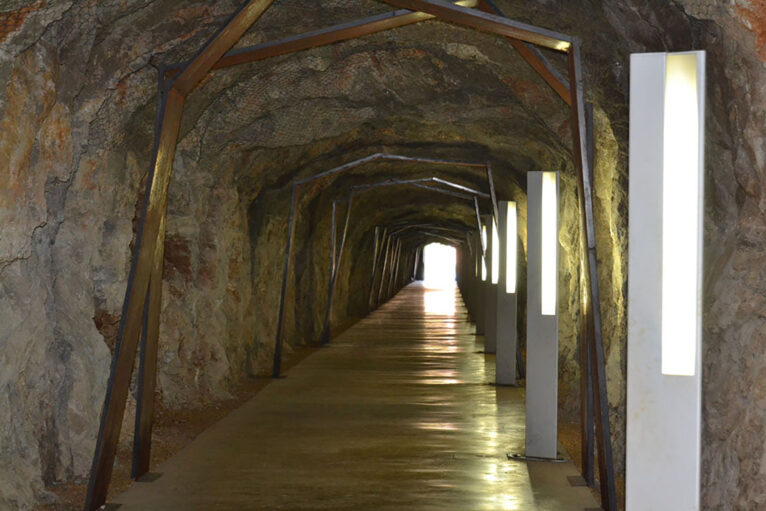
Tunnel under the Castle of Dénia
A rebuilt section of the city walls can be seen on Ronda de les Muralles street. By following the links (in Spanish), you can find more information about the Castle fortifications and city walls of ancient Dénia.
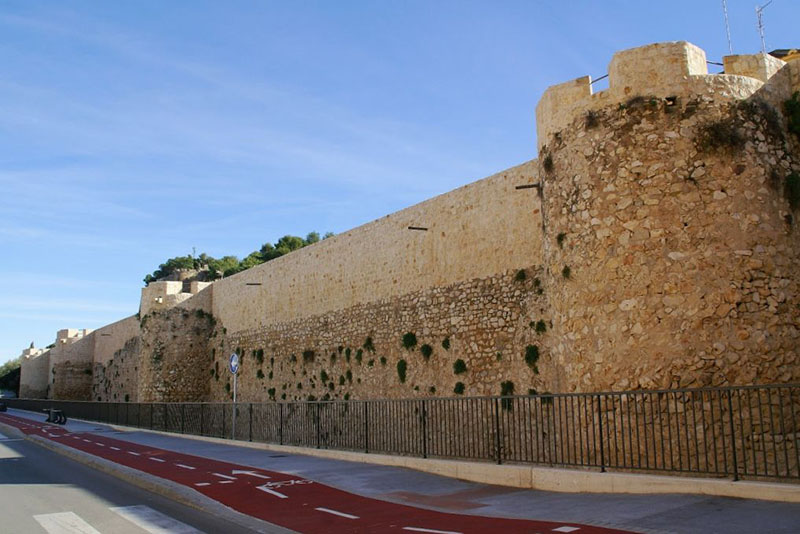
View of the ancient city walls at Ronda de less Muralles street
During the Middle Ages and well into the 17th century, the sea reached very close to the Castle walls, particularly along the eastern and northeastern sides, an area that today corresponds to the Ronda de les Muralles. At that time, this part of the fortress faced directly onto the coastline and was fortified, forming an essential part of the city’s natural coastal defenses against potential maritime attacks.
Visiting hours, Tickets and Prices
Hours. Dénia Castle opens its doors at variable times throughout the year, depending on the hours of sunlight:
- Between the months of November and March, from 10:00 a.m. to 18:00
- April and May from 10:00 to 19:00, and in June until 19:30
- June from 10:00 to 19:30
- July and August from 10:00 to 20:30
- September from 10:00 to 20:00
- October from 10:00 to 19:30
In summer, without previously defined date, there is a period in which you can visit the castle until 00:30 at night, in the so-called Visit the Castle by night. The information telephone number is +34 966 420 260.
Ticket prices. Residents of Dénia and those born in the city can access it for free, showing their ID with their address or place of birth. Tourists and visitors have to pay an entrance fee of €3. Children under 8 years old: free, and boys and girls between 8 and 16 years old: €1. The fare for retirees, pensioners and students is €2, as well as for groups of more than 25 people.
Guided tours. If you want information about visits to Dénia Castle, you can contact the telephone numbers +34 966420260 and +34 966420656. Generally, visits are organized in summer and do not have a fixed schedule. They will inform you at the Castle ticket office and you can also consult the Dénia City Council website.
Self Tour suggested: Castle of Dénia Self Tour
Short History of the Castle
This fortification, of Andalusian Muslim origin, dates back to the 10th and 11th centuries. However, much earlier Roman remains have been found on the castle slope, dating back to the time of Roman Dianium that existed on this site.
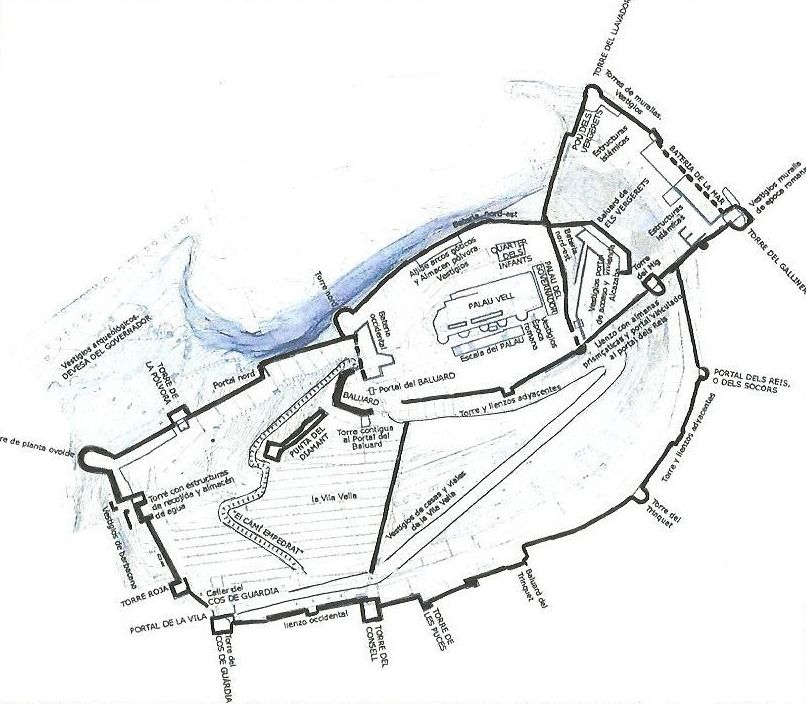
Map of the Castle of Dénia and its fortifications
Muslim Era
The castle was the citadel or residence of the governor of Dāniyya (Dénia). In the 10th century it reached its structure with the double enclosure of the citadel and the albacar (walled enclosure used as a refuge for the inhabitants), and with relevant fortification architectures. During the second half of the 11th century, important reinforcement works were carried out, as can be evidenced from the architectural studies.
Within the citadel lies the Portal de la Vila, the main entrance to the castle, characterized by pointed horseshoe arches and a split keystone, alongside the Torre del Cos de Guardia, which was built to guard this gateway. The Vila Vella (Old Village) was connected to the Palau Vell (Old Palace) in the citadel through the Portal del Baluard.


Left: Porta de la Vila, Main entrance and Torre del Cos de Guardia. Right: Portal del Baluard
The Torre del Mig (Mig tower) is one of the most notable structures of the Dénia Castle, built in the 11th century and considered a gem of 12th-century military architecture. This tower is part of the fortified enclosure and is known for its double horseshoe arches and alfiz, reflecting its Islamic origin. Additionally, the Mig Tower served as an important access point to the walled enclosure, and its design includes a bent entrance to enhance its defensive function.
The Reconquest
After the conquest of Dénia by Jaume I in 1244, the spaces of the enclosure changed their use: they hosted the Palau (Palace), Castell (Castillo) and Vila. In the year 1308, in the lower enclosure was the albacar (Villa Vella), while the citadel, with the Palau Vell (Old Palace), became the citadel. In this area, around the year 1600, the Renaissance palace, built by Francisco Gómez Sandoval y Rojas, Duque de Lerma and Marqués de Dénia, was integrated. This is what was once the Governor’s Palace and today it is the headquarters of the Archaeological Museum of the city (moved to Calle Caballeros).


Left: Governor’s Esplanade. Right: Watch tower
From the 16th century, the continuous harassment of the Berber pirates forced to improve the fortification of the precincts of the Vila and the Castell with the construction of bastions (to resist enemy attacks), leaving an important mark of Renaissance military architecture.
Modern Era
In successive centuries, wars leave their mark on the Castle of Dénia. The War of the Spanish Succession (1701-1713) devastated the Vila Vella and a good part of the fortress and walls, and the assault during the French invasion (1812) damaged the southern front of the two enclosures.
According to several sources, by 1826 the castle had been declared to be in complete ruin, and in 1860 it was officially abandoned for military purposes. It was sold and purchased by a local farmer. By 1890, reports described the castle as nothing more than a total ruin. With the arrival of the 20th century, the castle, now in private hands, was converted into an agricultural estate focused on vine cultivation and the production of pansa (grape raisins). During this time, terraces were built for farming, and retaining walls were constructed.
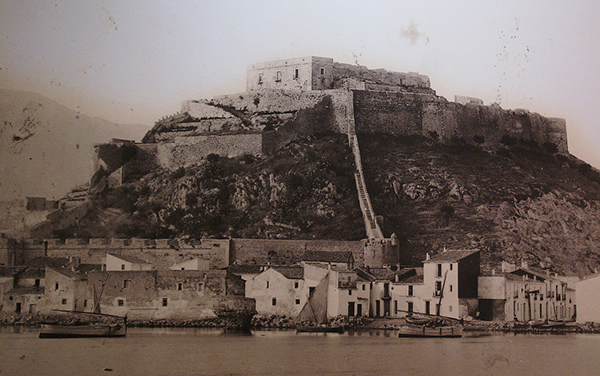
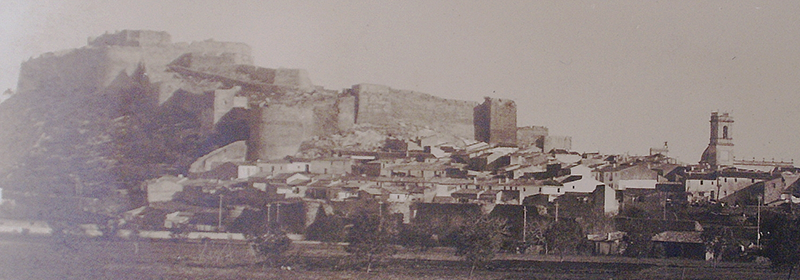
Views of the Castle from the port (above) and Northwest (below) (Circa 1900)
From the 20th Century to the Present
In the first decades of the 20th century, the north slope of the castle was used as a quarry for the extraction of stone. In 1947 after a complex expropriation process, the castle became municipal property. Since 1952, different remodeling actions have been promoted, such as the planting of trees throughout the premises, the fitting out of accesses or the restoration of rooms such as the Torre del Consell or Portal de la Vila. In the 60’s and 70’s, with the boom of tourism, an access road to the upper part was built, demolishing a significant part of the walls and destroying archaeological remains of the Vila Vella.
The premises of the Governor’s Palace were restored at the beginning of the 1980’s. The Galliner Tower and the Red tower were rehabilitated. Also in these years various bastioned constructions and wall canvases were consolidated.
Already in the 21st century, new spaces in the monumental complex were enabled, such as La Sala, used as a conference room, or the Visitor Center, next to the Palau esplanade. The rehabilitation of the staircase of the Palau (Governor’s palace) means recovering the experience of accessing the palace rooms. In 2020, the Verger Alt and the eastern bastion of the castle were rehabilitated with Renaissance military architecture of the mid-16th century, which for many years have been closed due to the lack of safety conditions for visitors. Now the Verger Alt is a new exhibition space, which corresponds to the old access to the citadel.
Dénia Castle at a glance (Video in Spanish)
